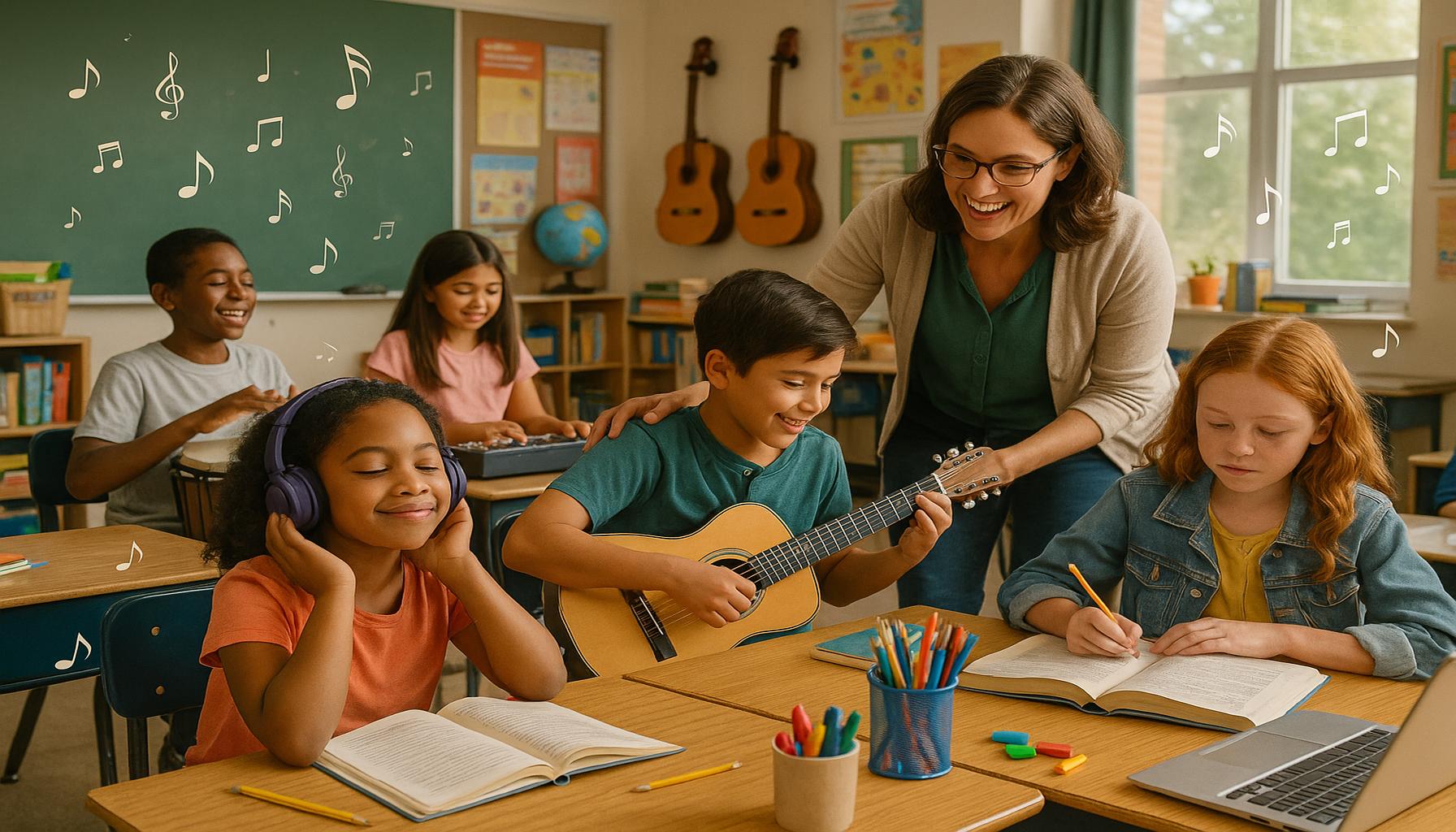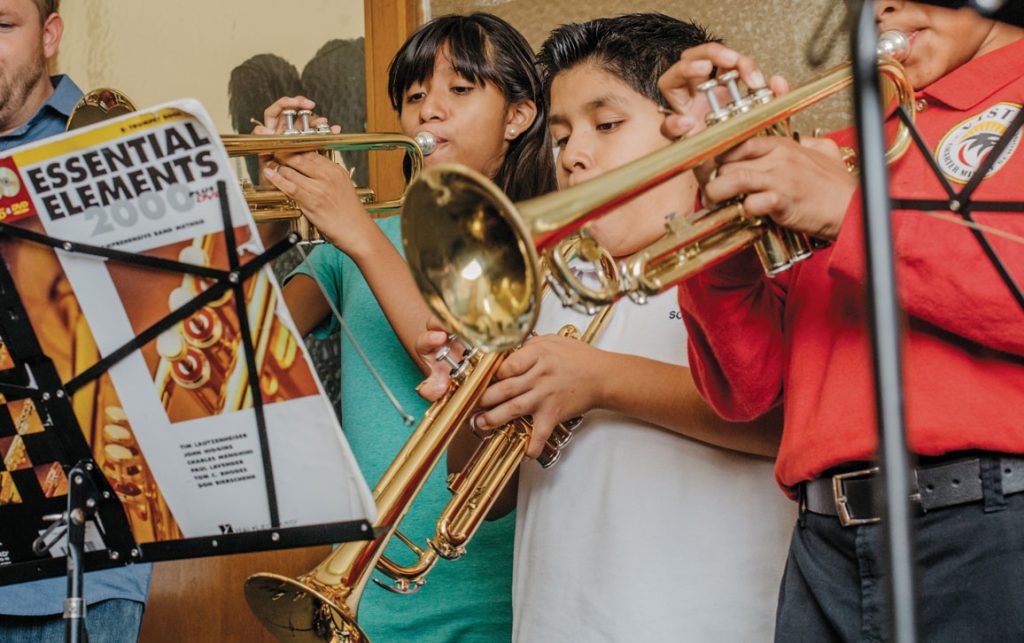The Influence of Music on Learning: How Harmonies and Rhythms Can Enhance the Educational Process

Introduction to Music’s Role in Education
In today’s educational landscape, the significance of music is becoming increasingly pronounced. Various studies reveal that harmonies and rhythms serve as powerful tools in enhancing the learning experience. Whether in classrooms or at home, music can transform the way students engage with educational materials. This integration is not merely an artistic endeavor; it’s a powerful educational strategy that can reshape cognitive processes and stimulate creativity.
Research shows that music influences learning through several key mechanisms:
- Increased focus: Background melodies can help students concentrate on tasks. For example, classical music has been shown to create an environment conducive to studying by minimizing distractions and enhancing focus during learning sessions.
- Improved memory: Rhythm and melody can aid in the retention of information. The “Mozart Effect,” for instance, is a well-documented phenomenon suggesting that listening to Mozart’s compositions may boost spatial-temporal reasoning and memory recall, particularly in young children.
- Cognitive development: Engaging with music fosters critical thinking and creativity. In many preschool programs, children learn the alphabet through song—an approach that not only makes learning fun but also enhances verbal skills and cognitive retention.
These findings underline an important aspect of modern education: the integration of music caters to diverse learning styles. For example, auditory learners may benefit from musical mnemonics, while visual learners may appreciate the interplay of lyrics and imagery in educational songs. As educators increasingly advocate for creative approaches, there is a shift towards more holistic curricula that embrace these elements. Through interactive music activities, students develop not just academic skills but also social and emotional intelligence by collaborating with peers in musical settings.
As we dive deeper into the relationship between music and learning, we’ll explore innovative techniques and the potential benefits they hold for students across different age groups. For instance, implementing music-based activities in subjects like mathematics—using songs to teach multiplication tables—has been observed to significantly enhance understanding and retention. Discover how the world of harmonies can make a significant impact on educational outcomes, paving the way for a more engaging and enriched learning environment. Experience firsthand the transformative power of music in academia, and uncover strategies that can be easily incorporated into educational practices, enriching the learning journey for all students.
DIVE DEEPER: Click here to uncover the power of music therapy</a

The Science Behind Music and Learning
The profound impact of music on the learning process can be traced back to various domains of cognitive science. At its core, the interaction between harmonies and rhythms not only creates an enjoyable atmosphere but also fortifies the underlying cognitive processes. The brain is inherently wired to respond to musical stimuli, with research demonstrating that exposure to music activates multiple regions involved in memory, attention, and emotion.
One significant area of interest is the Neuroscience of Music, which examines how musical engagement can enhance neural connections. Studies indicate that listening to music prior to studying can lead to better retention and recall of information. The structure of music, characterized by repeating sequences and patterns, mirrors the cognitive framework that helps individuals encode and retrieve knowledge effectively.
Additionally, music has been shown to affect mood and motivation—two critical components of effective learning. When students listen to music that elevates their mood, they are more likely to approach learning tasks with enthusiasm. Conversely, music that has a calming effect can help alleviate anxiety during high-pressure assignments or tests. For instance, teachers have integrated soft instrumental music into their classrooms, significantly boosting students’ performance when completing challenging tasks.
Benefits of Incorporating Music in Education
The application of music in educational settings extends beyond mere background noise. It serves a strategic purpose in enhancing various aspects of learning, including:
- Emotional regulation: Music can help students manage their emotions, creating a more conducive learning environment.
- Enhanced creativity: Exposure to musical activities encourages creative thinking, inspiring students to devise innovative solutions to problems.
- Engagement and retention: Using music in lessons can make subjects more relatable and memorable, bridging connections to real-life experiences.
- Motor skills development: Rhythmic activities and music movement can aid in the development of fine motor skills, particularly in younger learners.
Furthermore, institutions across the United States are witnessing a shift towards integrating music-based learning techniques into their curricula. Programs that incorporate music in subjects like history or science have reported increased engagement and enthusiasm from students, fostering a deeper understanding of the material. For example, history lessons that utilize songs to narrate events allow students to connect emotionally with the content, ultimately leading to improved retention rates.
As music continues to permeate educational practices, it is clear that the harmony between education and music is not merely a passing trend but a fundamental facet of effective teaching. The invitation to educators is to explore these dynamic connections further, leveraging the innate power of music to transform the learning landscape and elevate educational outcomes.
As the exploration of the influence of music on learning continues, it becomes increasingly clear that the integration of harmonies and rhythms in educational environments can provide numerous benefits. Research has shown that music acts as a powerful cognitive tool, enhancing memory retention and improving concentration among students. When students are exposed to music while learning, particularly genres that are calming and structured, their ability to process information increases significantly. This phenomenon can be attributed to the brain’s natural inclination to respond positively to musical stimuli, thereby fostering an environment conducive to learning.
Moreover, music can enhance a learner’s emotional well-being, which is a crucial aspect of the educational process. Studies indicate that students who engage with music while studying report lower levels of stress and anxiety. Exposure to harmonious melodies can create a serene atmosphere, allowing students to feel more comfortable and focused during their learning sessions. This emotional regulation is essential in maximizing the effectiveness of educational encounters.
Additionally, incorporating music into lesson plans can foster creativity and critical thinking among students. When learners interact with different musical elements, they are encouraged to think outside the box, connecting concepts across various disciplines. For instance, rhythmic patterns can be linked to mathematical concepts, while lyrical analysis can enhance language skills. Thus, music serves not only as a backdrop for learning but as a dynamic instrument for educational innovation.
Finally, the social aspect of music should not be overlooked. Group activities involving music, like singing or playing instruments, promote teamwork and collaboration among students. Engaging in these social musical experiences encourages communication skills and builds a sense of community within the classroom, ultimately enriching the overall learning experience.
| Category | Benefits |
|---|---|
| Cognitive Enhancement | Improves memory retention and focus. |
| Emotional Well-being | Reduces stress and anxiety, fostering a positive learning environment. |
| Creativity and Critical Thinking | Encourages innovative problem-solving across disciplines. |
| Social Interaction | Promotes collaboration and communication skills among students. |
DIVE DEEPER: Click here to learn more about sustainability trends
Applications of Music in Diverse Educational Contexts
As the exploration of music’s impact on learning gains momentum, its applications in various educational contexts become ever more evident. From elementary schools to higher education institutions, the integration of musical elements enriches the learning environment and caters to diverse learning styles.
One notable example can be observed in early childhood education, where music and movement activities are designed to stimulate cognitive development and physical coordination. Programs like “music and movement” classes have been implemented in preschools across the United States, allowing young learners to express themselves through songs and rhymes while honing their linguistic skills. Research indicates that children exposed to music in their formative years demonstrate improved verbal skills and phonological awareness, crucial components for future literacy success.
In primary and secondary education, music finds its place as a versatile teaching tool. Educators are creatively using song lyrics to convey complex themes in literature or tackle intricate mathematical concepts. For instance, a teacher may employ popular songs that resonate with students’ lives to teach principles of rhyming, rhythm, or syllabication, making learning not just informative but also engaging. Furthermore, studies show that employing musical mnemonics—the use of songs or melodies to aid memorization—can produce significant improvements in students’ ability to recall information. This technique has been particularly effective in subjects such as foreign language acquisition, where melody often aids pronunciation and retention.
The benefits of music extend beyond the elementary classroom setting; in higher education, music is being harnessed to foster collaboration and critical thinking. For example, music technology courses encourage students to collaborate on composition projects and analyze musical structures, honing their skills in teamwork and problem-solving. These hands-on experiences not only deepen students’ understanding of theoretical concepts but also promote a sense of community, enhancing the educational experience.
Technology and Music Integration
The proliferation of technology has further amplified the potential of music in learning. Educational platforms now offer numerous resources that combine music with interactive learning modules. For instance, digital applications allow students to create their own music compositions while learning about harmony, rhythm, and sound theory. This fusion of technology and music enables personalized learning experiences where students can explore their individual creativity alongside academic objectives.
Additionally, virtual reality (VR) environments are emerging as venues for immersive musical experiences. Some programs allow students to step into historical moments accompanied by the soundtrack of the time, or engage in interactive music lessons that translate theory into practice. This level of engagement is particularly compelling, as it combines the emotional resonance of music with the active participation of learners, making complex subjects accessible and enjoyable.
In conclusion, as educators continue to recognize the wide-ranging benefits of music on learning outcomes, the evidence suggests that a multidimensional approach integrating harmonies and rhythms can serve as a powerful catalyst for educational advancement. With ongoing research and technology development, it is clear that the relationship between music and learning will continue to evolve and inspire innovative educational practices.
DISCOVER MORE: Click here to dive into digital art tools
Conclusion: The Unmatched Potential of Music in Learning
As we have explored the influence of music on learning, it becomes increasingly apparent that harmonies and rhythms hold an unparalleled potential to enhance the educational process. From the foundational stages of early childhood education, where music fosters cognitive and linguistic growth, to its transformative role in higher education, where collaborative musical projects cultivate critical thinking and teamwork, the integration of music positively impacts learners of all ages.
The scientific evidence supporting the connection between music and enhanced learning outcomes cannot be overlooked. Techniques such as musical mnemonics and thematic song integration not only engage students but also create lasting impacts on memory recall and comprehension across various subjects. Furthermore, the rise of technology within educational settings has unlocked unprecedented opportunities for personalized learning experiences, making it easier for students to explore their creativity while mastering academic content.
As we move forward, it is crucial for educators, policymakers, and stakeholders to recognize and embrace the potential that music has to offer in enriching educational environments. The trends suggest a need for continued research and innovative practices that utilize music as a comprehensive learning tool. Future initiatives may redefine educational paradigms, making learning a dynamic and engaging experience driven by the universal language of music. By harnessing the rhythms of knowledge and the melodies of understanding, we can pave the way for a more vibrant, effective educational landscape, ensuring that the influence of music continues to resonate within classrooms across the nation.


